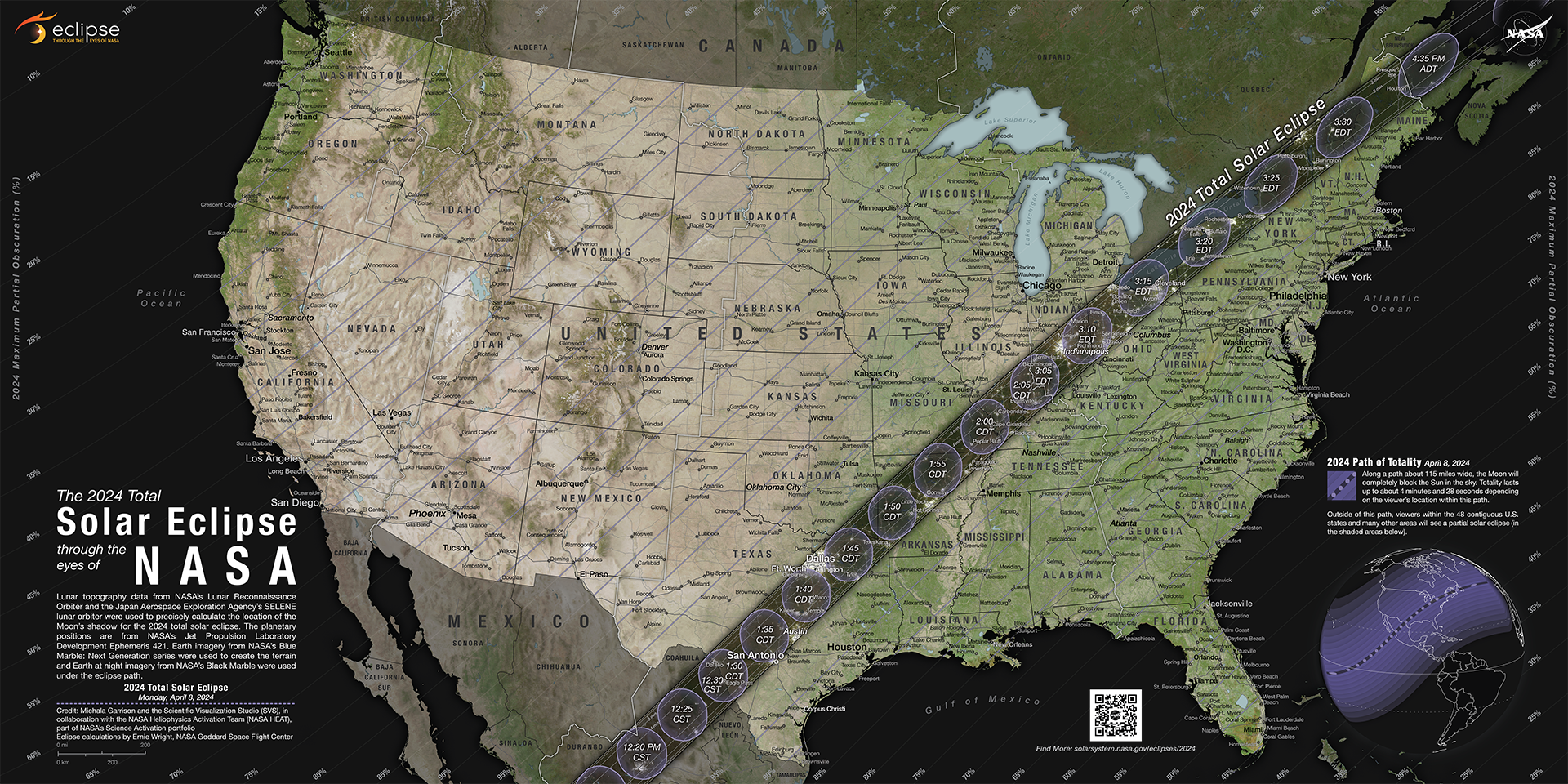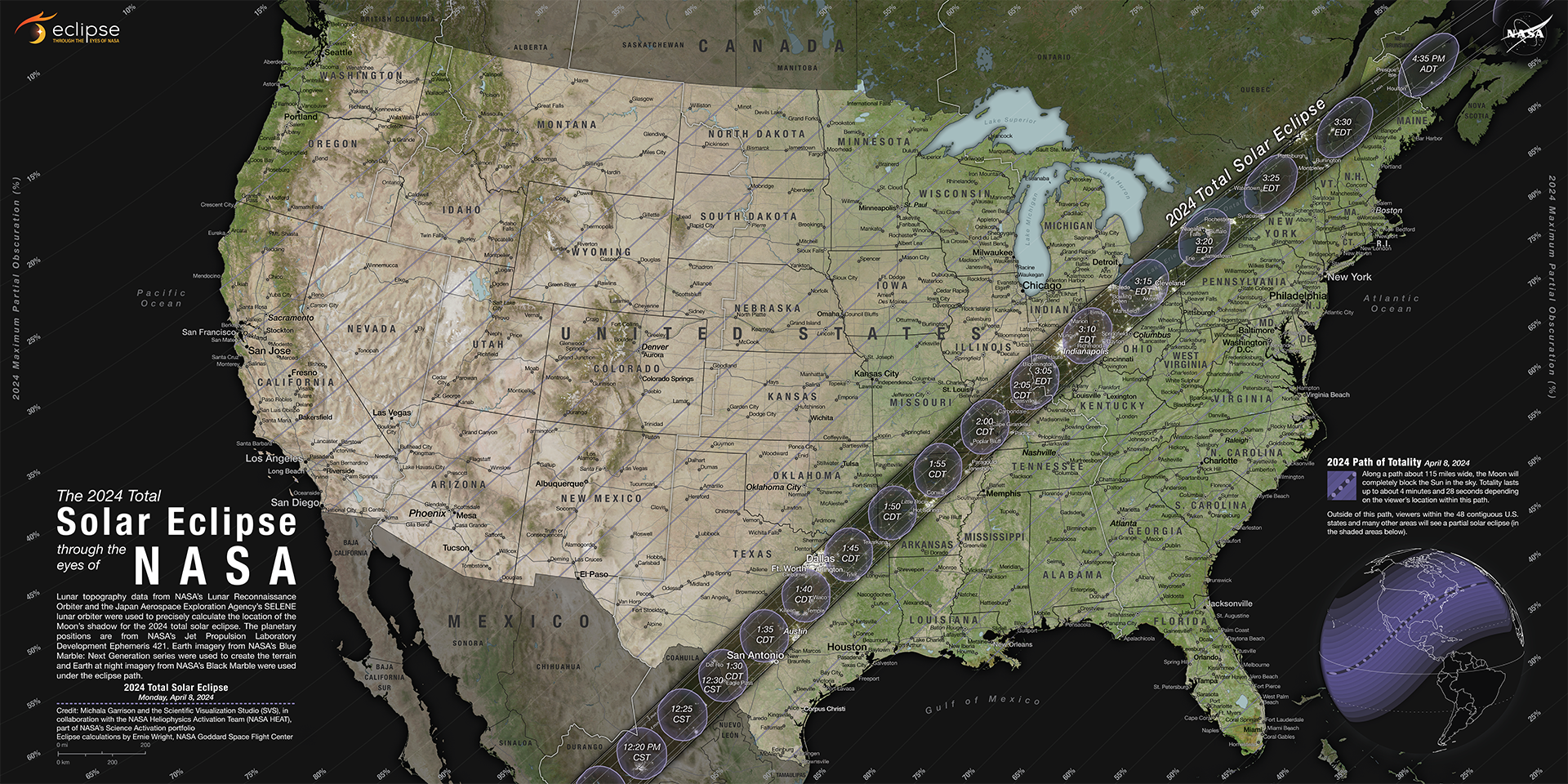Earth
Sun
Planets and Moons
ID: 5123

This map illustrates the paths of the Moon’s shadow across the U.S. during the 2024 total solar eclipse. On April 8, 2024, a total solar eclipse will cross North and Central America creating a path of totality. During a total solar eclipse, the Moon completely blocks the Sun while it passes between the Sun and Earth. The sky will darken as if it were dawn or dusk and those standing in the path of totality may see the Sun’s outer atmosphere (the corona) if weather permits.
Also within the dark path are duration contours. These delineate the length of time totality will last. The closer to the center of the solar eclipse path, the longer it will last. For the total path, times range up to 4 minutes.
Outside the eclipse path, the map displays contours of obscuration, or percentage of the Sun’s area covered by the Moon. Readers can trace the lines to percentages printed along all sides of the map that range from 95% to 10% obscuration. The dark path marks when 100% obscuration begins.
The .zip file above contains the following files:




The 2024 Total Solar Eclipse

Making the Map
This map uses datasets from several NASA missions. The eclipse data were calculated by visualizer Ernie Wright using elevation information from SRTM, lunar topography from LRO, and planetary positions from the JPL DE421 ephemeris. The lead visualizer, Michala Garrison, used Earth imagery from NASA’s Blue Marble Next Generation to create the terrain map. Likewise, nighttime Earth imagery from NASA’s Black Marble were used along the path of the 2024 total solar eclipse.Reading the Map
The dark path across the map is where the largest area of the Sun will be covered by the Moon. People in this path will experience a total solar eclipse. Inside the dark eclipse path are irregular ovals that delineate the Moon’s shadow on the Earth’s surface. For a total solar eclipse, the ovals are called the umbra and create the path of totality. On the map, the ovals contain times inside corresponding to the shape of the Moon’s shadow cast at that time during the eclipse.Also within the dark path are duration contours. These delineate the length of time totality will last. The closer to the center of the solar eclipse path, the longer it will last. For the total path, times range up to 4 minutes.
Outside the eclipse path, the map displays contours of obscuration, or percentage of the Sun’s area covered by the Moon. Readers can trace the lines to percentages printed along all sides of the map that range from 95% to 10% obscuration. The dark path marks when 100% obscuration begins.
Download Eclipse Data
2024 Total Solar Eclipse Data: 2024eclipse_shapefiles.zipThe .zip file above contains the following files:
- center.shp A high-resolution polyline tracing the path of the shadow center. Region limited.
- duration.shp Isocontours of maximum total duration, at 30-second intervals.
- ppath.shp “Penumbra path,” contours of maximum partial obscuration (area of the Sun covered by the Moon) at 5% intervals.
- ppath01.shp “Penumbra path,” contours of maximum partial obscuration (area of the Sun covered by the Moon) at 1% intervals.
- umbra_hi.shp High resolution umbra polygons, at 1-second intervals. Region limited.
- umbra_lo.shp Lower resolution umbra polygons, at 10-second intervals. Global.
- upath_hi.shp High resolution path shape. Region limited.
- upath_lo.shp Lower resolution path shape. Global.
More Map Versions




Source Material
Visualization Credits
Michala Garrison (SSAI): Lead Visualizer
Laurence Schuler (ADNET Systems, Inc.): Technical Support
Ian Jones (ADNET Systems, Inc.): Technical Support
Ernie Wright (USRA): Visualizer
Laurence Schuler (ADNET Systems, Inc.): Technical Support
Ian Jones (ADNET Systems, Inc.): Technical Support
Ernie Wright (USRA): Visualizer
Please give credit for this item to:
NASA's Scientific Visualization Studio
NASA's Scientific Visualization Studio
Short URL to share this page:
https://svs.gsfc.nasa.gov/5123
Data Used:
Note: While we identify the data sets used in these visualizations, we do not store any further details nor the data sets themselves on our site.
Keywords:
SVS >> Solar Eclipse
SVS >> Hyperwall
SVS >> Eclipse
NASA Science >> Earth
NASA Science >> Sun
NASA Science >> Planets and Moons
SVS >> Total Solar Eclipse
https://svs.gsfc.nasa.gov/5123
Data Used:
SRTM/SIR-C
Terra and Aqua/MODIS/Blue Marble Land Cover
Credit:
The Blue Marble data is courtesy of Reto Stockli (NASA/GSFC).
The Blue Marble data is courtesy of Reto Stockli (NASA/GSFC).
LRO/LOLA/Digital Elevation Map also referred to as: DEM
JPL DE421 also referred to as: DE421
Ephemeris - NASA/JPL
Planetary ephemerides
LRO/SELENE/LOLA/TC/DIgital Elevation Model also referred to as: SLDEM2015
Model
A digital elevation model of the Moon derived from the Lunar Orbiter Laser Altimeter and the SELENE Terrain Camera. See the description in Icarus. The data is here.
Suomi NPP/VIIRS/Black Marble: Next Generation also referred to as: Black Marble
NASA/NOAA
Earth at night imagery
Credit:
NASA Earth Observatory images by Joshua Stevens, using Suomi NPP VIIRS data from Miguel Román, NASA GSFC.
NASA Earth Observatory images by Joshua Stevens, using Suomi NPP VIIRS data from Miguel Román, NASA GSFC.
Keywords:
SVS >> Solar Eclipse
SVS >> Hyperwall
SVS >> Eclipse
NASA Science >> Earth
NASA Science >> Sun
NASA Science >> Planets and Moons
SVS >> Total Solar Eclipse











